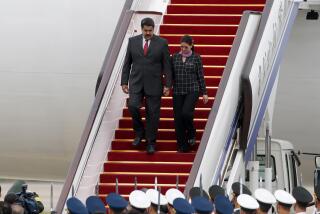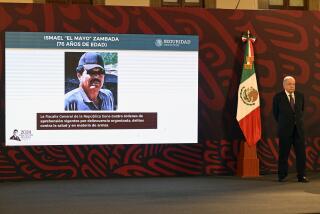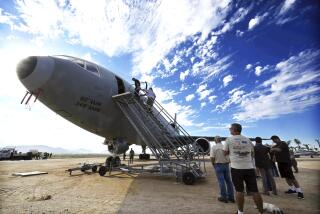Pilot of Downed Plane Flew for CIA in Vietnam Era
- Share via
WASHINGTON — The Nevada aviator killed when a cargo plane was shot down in Nicaragua last weekend served as one of the CIA’s chief pilots in Southeast Asia during the Vietnam era and appears to have played a key role in managing and recruiting personnel for the arms supply operation that cost him his life.
Those details emerged Thursday from interviews with friends of William J. Cooper, 62, of Reno, the dead pilot, and with sources familiar with covert efforts to aid the rebels, known as contra s, who are fighting the leftist Nicaraguan government.
From President Reagan down, U.S. officials have denied any government involvement in the arms supply operations.
In another development Thursday, a State Department official confirmed that Cooper had flown at least one supply mission under a now-defunct government program of non-military aid for the Nicaraguan rebels.
“Cooper was a pilot for one of the contractors,” said Philip J. Buechler of the State Department’s Nicaraguan Humanitarian Assistance Office. Buechler said he did not recall the air transport firm for which Cooper flew.
Sandinista troops found Buechler’s business card in the wreckage of the plane. “I gave him my business card,” Buechler said in an interview. The aid program Buechler headed shipped boots, military belts and other “non-lethal” equipment to the contras before it expired in May.
Cooper’s past ties to the CIA were described by William Leary, a University of Georgia professor who said he spent several days with the pilot at his Nevada home two years ago while researching a book on the CIA’s covert air transport operations in Southeast Asia in the 1960s and 1970s.
“He was one of the chief pilots for Air America,” the company operated by the CIA, Leary said in a telephone interview. “He was a very good pilot and was especially proficient in air drops.” The company secretly delivered supplies to anti-Communist forces in Laos and other areas outside the war zone.
‘Sense of Adventure’
Leary said that Cooper “didn’t fly just for the money. Sure, there was a sense of adventure, but it was also for what he considered a good cause.”
In Reno, where Cooper has lived off and on since 1949, a friend displayed a 1973 newsletter distributed to Air America employees that had a photograph of Cooper in uniform and identified him as the head of a training program for the Laotian air force.
The friend, a former Air America employee who asked to remain anonymous, showed a reporter a June, 1969, flight log for Air America operations out of Vientiane, the Laotian capital. When asked who he worked for, the friend replied: “We always referred to them as the ‘customer.’ I don’t really know who we worked for.”
One of Cooper’s three daughters, Joni, saw her father’s photograph on television after his identity card, recovered from the crashed plane, was displayed by Nicaraguan officials. She telephoned Reno television station KTVN, which later reported that Cooper had left Reno four months ago. The daughter said in a television interview that she learned only after she was an adult that her father flew for the CIA.
Leary said that Eugene Hasenfus, the crewman who survived the crash and is now being held by Nicaraguan authorities, was an Air America employee during the same time period as Cooper.
Hasenfus, in a statement broadcast Thursday by the Nicaraguan government, said that Cooper had recruited him for the recent Central American operation.
Cooper also was identified Thursday as the person who supervised maintenance performed this year on the ill-fated C-123 by Southern Air Transport, a Miami firm once owned by the CIA.
CIA Relationship Denied
An official of the Miami company said that Cooper had never worked for the firm, but that he was issued a company identity card so he could have access to the hangar to oversee the plane’s maintenance. The official, William Kress, also denied that Southern Air now has links to the CIA, which sold the firm in 1973. “We have no relationship whatsoever with the CIA,” he said.
Meanwhile, in an odd twist, it was reported that the plane shot down in Nicaragua may have been the same aircraft outfitted with cameras by the CIA in 1984 for a drug sting operation that led to the indictment of a Sandinista official.
The Miami Herald, quoting court testimony and unidentified sources, said that the C-123 cargo plane is believed to be the same craft flown by Adler (Barry) Seal, a drug smuggler turned government informant, when he photographed the official, Federico Vaughan, helping load cocaine into the plane at a Central American air field.
Vaughan, identified as an employee of the Nicaraguan Interior Ministry, was indicted in Miami but remains a fugitive. Seal was murdered in Baton Rouge, La., last February.
Also on Thursday, an FBI spokesman in Washington said that the agency is conducting a “preliminary inquiry” to determine if a U.S. law, known as the Neutrality Act, had been violated by the efforts to resupply the rebels resisting the Sandinista government.
Asked what prompted the investigation, the spokesman said that “if a credible source brings forth allegations that a law has been violated, then someone has to determine” if it’s so.
The Neutrality Act forbids private individuals from carrying out military operations from U.S. soil against countries that are not at war with the United States. When shot down Sunday, the plane reportedly was carrying 50,000 rounds of ammunition, rocket-propelled grenades, dozens of automatic rifles, boots and other supplies.
Gaylord Shaw reported from Washington and Dan Morain reported from Reno.
More to Read
Sign up for Essential California
The most important California stories and recommendations in your inbox every morning.
You may occasionally receive promotional content from the Los Angeles Times.










